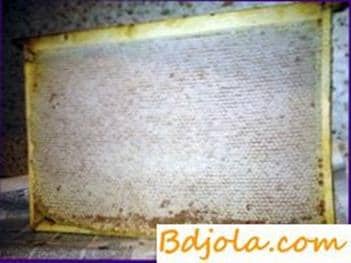
The pumped honey crystallizes within 2-3 months. Separate honey (for example, with labial and legume plants) persists for a long time in the liquid state. Honey in honeycomb, sealed with wax lids, usually for a long time is in a liquid state. However, it can crystallize in the honeycomb. In the winter, this leads to the death of bees or the sharp deterioration of their wintering, and in the spring to sugar losses (bees crystals are thrown out of the hive) and the high energy costs of bees to dissolve it.
Crystallization of honey depends on the presence in it of small germinal crystals, which the bees transfer to the hive. These crystals are formed by drying nectar in a flower in dry years. Therefore, in dry years honey in the hives crystallizes more often than in years with normal humidity.
Primary crystals are formed and on the walls of the cells, in which the remaining droplets of honey dribble after pumping out on the honey extractor.
Crystallization of honey depends on its chemical composition. Honey containing an increased amount of glucose, crystallizes faster. The increased content of fructose, dextrins, soluble protein, on the contrary, retards crystallization.
Embryonic crystals can always be found in perfectly clear liquid honey. These crystals serve as centers around which the druses of crystals are formed, covering gradually the entire mass of honey.
The center of crystallization can be pollen grains, always contained in honey. Embryonic crystals completely dissolve during prolonged heating of honey. The liberation of honey from the pollen grains is achieved by its filtration, which for a long time preserves its liquid consistency.
Heather and eucalyptus honey are particularly prone to crystallization. Also, honey from cruciferous plants – mustard, rape, rapeseed and sunflower – crystallizes quickly (in arid years).
The honey crystallizes most rapidly at a temperature of 13-14 њ C. Both a decrease in temperature and a rise in temperature delay crystallization. At low temperatures, the viscosity of honey increases, which retards crystallization. At a temperature of 27-32 њ C, the honey of most plants does not crystallize at all. Staying honey in a well-insulated nest of bees is an important condition for keeping it in a dissolved state. Sharp changes in heat and cold in the hive lead to a significant acceleration of crystallization.
To prevent the crystallization of honey in honeycombs, the following requirements must be met:
1. Do not leave bees for the winter honey varieties, predisposed to rapid crystallization (from heather, rapeseed, mustard, rape), and also from cotton and sunflower, the nectar from which was collected by bees in a dry summer. If you failed to replace such honey with sugar, then from the middle of the winter, give bees water or top dressing-liquid sugar syrup.
2. In the autumn, keep the bees in the reduced nests with honeycombs, densely covered with bees, carefully warm them, reduce the tapholes, keep the hives in a place well protected from the winds. In this case, the honey reserves will not be sharply cooled by cold snaps and warm up in the thaw.
3. Honey combs, intended for long-term storage, immediately after the selection from the hives must be brought into a room with a stable temperature, so that they are not subjected to intense warming during the day and cooling at night.
Use honeycombs with crystallized honey. In the spring, during the first inspection of the bees, honeycombs with crystallized honey should be taken from the hives, replacing them with honeycomb with liquid honey from the stock or with sugar syrup. When it gets warmer and the bees fly well, the selected honeycombs with the crystallized honey can be fed to the bees. For this, the honeycombs are introduced for a day in a warm moist room. Then all the honey is unpacked and the remaining liquid part is pumped out on the honey extractor. Honeycombs with honey crystals remaining in the cells are brought into a warm, humid room (32-34S), sprinkled with warm water in the cells and put in a hive in a day. At regular inspections, the honeycombs are repeatedly sprayed with warm water to dissolve the remaining sugar crystals, and so repeat until all the crystals are completely dissolved.
Весеннее расширение пчелиного гнезда. Переработка воска.
Feeding base of beekeeping